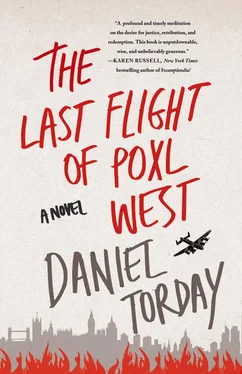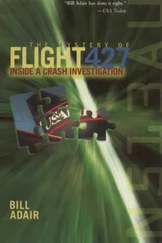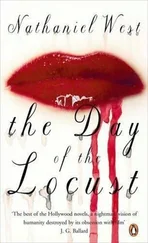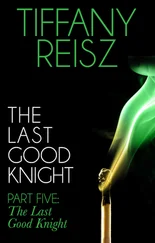I said I didn’t know.
“Up here,” Rabbi Ben said.
He was tapping at his temple with his forefinger.
“There was no ancient Aramaic text called the Zohar. There was a book that Moses de Léon wanted to write. A book based on how he saw Adonai, HaShem, the unspeakable represented by the Tetragrammaton, the God he wanted us to reach. And people wouldn’t listen to it from him, so he said he was translating some ancient text — and then he just went ahead and made up his story. That’s what people do when they write. They make up stories, details to fit the stories they need to tell. And people are still reading — worshiping — that book, almost seven hundred years later. I’ve basically given my whole spiritual life over to it.”
In the picture behind Rabbi Ben, that old, big-eared Kabbalah scholar looked down at us. For the first time I looked back. I needed a minute before I could respond. A minute when I wasn’t looking at Rabbi Ben. A minute when I wasn’t even thinking about what Poxl West would think. A minute when it was just what I thought, directly.
“So listen,” Rabbi Ben said. “I think it’s time for class.”
He’d never had anything but time for me. Today he’d said his piece. Maybe he thought it would be better for me not to respond. Maybe he understood what I know now: that I couldn’t possibly have processed all of what had been happening in those months enough to really say anything yet. Or maybe he just hadn’t ever had a rap session with anyone before and didn’t know how to end it. “We should get to the classroom. But if you want to bring Poxl West to my class some time in the future — anytime in the future, my man — you just bring him.”
I told him I’d give it some thought.
“Give it all the thought you want,” Rabbi Ben said. “When you know, I’ll know.”
For a year and then another year, we didn’t hear from Poxl. I went to Hebrew class and then I didn’t — I was confirmed in the temple, and there was no higher step. I did try to reach my uncle, and never extended an invitation for him to attend Rabbi Ben’s class. Uncle Poxl’s memory faded and that senescence was another absence, another void. No one mourns the death of a book. No fly buzzes at the death of a reputation. The prep school where he’d taught found a new teacher to take over his classroom. The Patriots were good, but not good enough to make it back to the Super Bowl. My father took me to Fenway a dozen times each summer — his firm got great seats. It would be almost two decades before the Red Sox returned to the World Series. By then, I had a kid of my own.
I found new things to write about for my senior history class. I got more interested in an art class my senior year than I thought I might, not having cared for art beyond those trips Poxl had taken me on to the MFA, where what I cared about was him and not the paintings on the walls. We studied modernism. When Mrs. Hornicker turned her brown plastic slide tray and an image of Les Demoiselles d’Avignon flashed up on the screen, I sat back. Here were women with a dozen faces each, all blocked in washed-out colors, as if through the scrim of a Boston winter. I read a biography of Picasso and wrote about him. I got an A+ for the first time in a year, and a “See me.”
“Your interest in Picasso is obvious,” Mrs. Hornicker said. “I’m going to take a small group of students up to MoMA in New York to see the permanent collection.” I asked my parents. They said yes.
A month later we were walking up Fifty-third Street. It was the first week in October, and the sky was so blue it seemed to push down toward the gray city pavement. I walked through air so crisp I felt as if a hand was at my back, pushing me forward with the ineluctable rhythm that seemed to carry the millions of humans rushing through Manhattan every midday.
Inside the museum we browsed through the permanent collection. Picassos were hung opposite Pollocks and de Koonings, Duchamps and Rauschenbergs. Here we were, standing before the very works we’d just been looking at in books, set against pale gray-painted walls. I walked with determination. Where the colors of Les Demoiselles had looked washed-out in our textbook, now I saw the painting was covered in bright vermilions, oranges like the jack-o’-lanterns we bought at Volente’s Farm every autumn. Something about that brilliance pushed me away. The ceilings of the place felt too low, painted too white. In the doorways of every room I moved to after seeing the Picasso were scowl-faced security guards. None of the faces on the myriad old women in furs who passed me was a Hepburn face. I walked around, looking for a painting with muted colors like the peach pinks I’d seen in the Picasso reproduction in my book at home.
In the last room I entered I came upon it: a watercolor of a girl with a large tuft of black hair. The canvas was beige, her face the same hue as the background. Her body was defined only by a dowdy black outline. Brushstrokes led down to blithely drawn legs. In between them, two curvilinear lines of gibbous, then concave labia. Just as my neck began to burn with my realization of their sex, as I recognized I was looking at a woman’s spread legs, a voice broke in.
“It’s a Schiele,” the voice said.
I turned. On the bench behind me, looking at this painting, was a wizened old man. I smelled the naphthalene on his suit before I saw him. He wore a blue Brooks Brothers suit and around his neck a scarf with two stripes in different shades of dark green. His face was blanched, hidden by a wiry red beard. “ Mädchen mit schwarzem Haar, Girl with Black Hair. Not a major work, but characteristic of the essentially pornographic watercolors he did when he was young and painting in Czesky Krumlov.”
The speech sounded like it had been written on the placard on the wall in the museum. This wiry man had been talking for longer than I’d like to remember before I realized it was my uncle Poxl. His face had undergone a transformation so violent it took me a moment to recognize him. His nose bore bright red bulbs. The red of veins spread back to his temples like a woman before she has properly rubbed in blush. The whites of his eyes were yellow. They, too, bore spreading red veins. Small patches all around his face were pocked with the white skin of scar tissue, remnants of hastily removed melanomas. He was still well dressed, my uncle, and he acknowledged me before I acknowledged him.
“I’d always wanted to take you to see Schieles,” Poxl said. He made no move to get up, but he patted the space beside him. “Not this, though,” he said. “No, no, you would have to see even more than this.”
I sat down next to him. For a moment we looked at the painting. Poxl didn’t turn to look at me. I started to say fifty-eight things but they all bottlenecked. Instead I said: “You come here often?”
“What kind of pickup line is this?” Poxl said. “You want an old man, he’s yours.” Space invisible as static electricity seemed to grow between us. My uncle realized how odd this bit of humor was and he quickly said, “For a time I worked as a docent at the Jewish Museum. That’s all I ever really wanted to do from the beginning— see masterpieces. I didn’t have to make them. Now I just come to look at the art.”
Once Poxl started talking, it was as if he couldn’t stop. He explained that in the time after he was discovered — that’s how he put it, “after I was discovered,” though it took me a while to realize he meant found to be a fraud, not discovered as a talent — he settled into an apartment he’d rented in Hell’s Kitchen. It was a short walk over to MoMA.
“I felt anonymous here amid all the great paintings,” he said. “All the real art.”
Читать дальше












